Author: 0xjacobzhao | https://linktr.ee/0xjacobzhao
As AI becomes the fastest-growing technological wave globally, computing power is being viewed as a new "currency," and high-performance hardware like GPUs is gradually evolving into strategic assets. However, financing and liquidity for such assets have long been limited. Meanwhile, crypto finance urgently needs to access high-quality assets with real cash flow, and the on-chainization of RWA (Real-World Assets) is becoming a key bridge connecting traditional finance and the crypto market. AI infrastructure assets, characterized by "high-value hardware + predictable cash flow," are widely regarded as the best breakthrough for non-standard asset RWA, with GPUs having the most realistic landing potential, while robots represent a longer-term exploration direction. Against this backdrop, GAIB's proposed RWAiFi (RWA + AI + DeFi) pathway provides a new solution for the "on-chain financialization of AI infrastructure," promoting the flywheel effect of "AI infrastructure (computing power and robots) x RWA x DeFi."
I. Outlook on AI Asset RWAization
In discussions about RWAization, the market generally believes that standard assets such as U.S. Treasuries, U.S. stocks, and gold will occupy a core position for a long time. These assets have deep liquidity, transparent valuations, and clear compliance paths, making them natural carriers of "risk-free interest rates" on-chain.
In contrast, the RWAization of non-standard assets faces greater uncertainty. Carbon credits, private credit, supply chain finance, real estate, and infrastructure have large market scales but generally suffer from issues such as opaque valuations, high execution difficulty, long cycles, and strong policy dependence. The real challenge lies not in the tokenization itself but in how to effectively constrain the execution of off-chain assets, especially in terms of disposal and recovery after defaults, which still rely on due diligence, post-loan management, and clearing processes.
Nevertheless, RWAization still has positive significance: (1) On-chain contracts and asset pool data are open and transparent, avoiding "black box" funding pools; (2) The yield structure is more diverse, allowing for additional returns through Pendle PT/YT, token incentives, and secondary market liquidity; (3) Investors typically hold securitized shares through SPC structures rather than direct debt claims, providing a certain degree of bankruptcy isolation.
In AI computing assets, hardware like GPUs is widely regarded as the primary entry point for RWAization due to its clear residual value, high standardization, and strong demand. The computing layer can also be further extended to computing lease contracts, which have a cash flow model that is contractual and predictable, making them suitable for securitization.
Following computing assets, robot hardware and service contracts also have RWAization potential. Humanoid or specialized robots, as high-value equipment, can be mapped on-chain through financing lease contracts; however, robot assets are highly dependent on operation and maintenance, making their implementation significantly more challenging than GPUs.
Additionally, data centers and energy contracts are also worth noting. The former includes cabinet leasing, electricity, and bandwidth contracts, which belong to relatively stable infrastructure cash flows; the latter, represented by green energy PPAs, not only provides long-term returns but also has ESG attributes, aligning with institutional investor needs.
Overall, the RWAization of AI assets can be divided into several levels: in the short term, focusing on computing hardware like GPUs and computing contracts; in the medium term, expanding to data center and energy contracts; and in the long term, robot hardware and service contracts are expected to achieve breakthroughs in specific scenarios. The common logic revolves around high-value hardware + predictable cash flow, but the paths to implementation differ.
Potential Directions for AI Asset RWAization
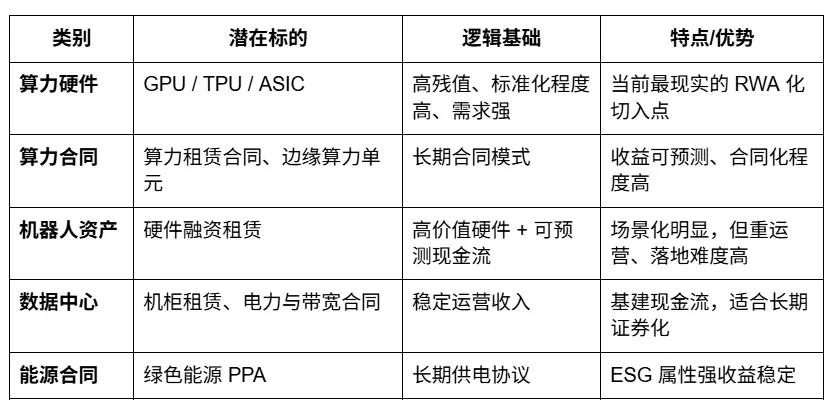
II. Priority Value of GPU Asset RWAization
Among many non-standard AI assets, GPUs may be one of the relatively more exploratory directions:
Standardization and clear residual value: Mainstream GPU models have clear market pricing and relatively defined residual values.
Active second-hand market: They have re-circulability, allowing for partial recovery in case of default;
Real productivity attributes: GPUs are directly linked to the demand of the AI industry, generating cash flow.
High narrative fit: Combining the dual market hotspots of AI and DeFi makes it easier to attract investor attention.
Since AI computing data centers belong to a very emerging industry, traditional banks often find it difficult to understand their operating models, thus unable to provide loan support. Only large enterprises like CoreWeave and Crusoe can obtain financing from large private credit institutions like Apollo, while small and medium-sized enterprises are excluded, making financing channels for SMEs urgently needed.
It should be noted that GPU RWA does not eliminate credit risk. Well-qualified companies can usually finance through banks at lower costs without necessarily needing to go on-chain; whereas those opting for tokenized financing are often SMEs, which carry higher default risks. This also leads to a structural paradox in RWA: high-quality asset parties do not need to go on-chain, while higher-risk borrowers are more inclined to participate.
Nevertheless, compared to traditional financing leases, the high demand, recoverability, and clear residual value of GPUs make their risk-return characteristics more advantageous. The significance of RWAization is not to eliminate risk but to make it more transparent, priceable, and liquid. As a representative of non-standard asset RWA, GPUs possess industrial value and exploratory potential, but their success ultimately depends on off-chain qualification review and execution capability, rather than purely on-chain design.
III. Frontier Exploration of Robot Asset RWAization
Beyond AI hardware, the robotics industry is also gradually entering the vision of RWAization. It is expected that by 2030, the market size will exceed $185 billion, with enormous development potential. With the arrival of Industry 4.0, a new era of intelligent automation and human-machine collaboration is accelerating, and in the coming years, robots will be widely deployed in factories, logistics, retail, and even households. Through structured on-chain financing mechanisms, the deployment and popularization of intelligent robots can be accelerated, while also creating investment entry points for ordinary users to participate in this industrial transformation. The feasible paths mainly include:
Robot hardware financing: Providing funds for production and deployment, with returns coming from leasing, sales, or Robot-as-a-Service (RaaS) operational income; cash flow is mapped on-chain through SPC structures and insurance coverage, reducing default and disposal risks.
Data flow financialization: Embodied AI models require large-scale real-world data, which can fund sensor deployment and distributed collection networks, and tokenize data usage rights or licensing income, giving investors a channel to share in future data value.
Production and supply chain financing: The robotics industry chain is long, involving components, production capacity, and logistics. Trade financing can release operating funds and map future goods flow and cash flow on-chain.
Compared to GPU assets, robot assets are more dependent on operations and scene implementation, and cash flow fluctuations are also more affected by utilization rates, maintenance costs, and regulatory constraints. Therefore, it is recommended to adopt shorter-term, over-collateralized, and higher reserve transaction structures to ensure stable returns and liquidity safety.
IV. GAIB Protocol: The Economic Layer of Off-Chain AI Assets and On-Chain DeFi
The RWAization of AI assets is moving from concept to implementation. GPUs have become the most feasible on-chain assets, while robot financing represents a longer-term growth direction. To truly endow these assets with financial attributes, the key lies in constructing an economic layer that can accommodate off-chain financing, generate yield certificates, and connect DeFi liquidity.
GAIB was born in this context; it does not directly tokenize AI hardware but instead puts financing contracts that use enterprise-level GPUs or robots as collateral on-chain, building an economic bridge connecting off-chain cash flow with on-chain capital markets. Off-chain, enterprise-level GPU clusters or robot assets purchased and used by cloud service providers and data centers serve as collateral; on-chain, AID is used for stable pricing and liquidity management (non-interest-bearing, fully reserved in T-Bills); sAID is used for yield exposure and automatic accumulation (underlying is a financing portfolio + T-Bills).
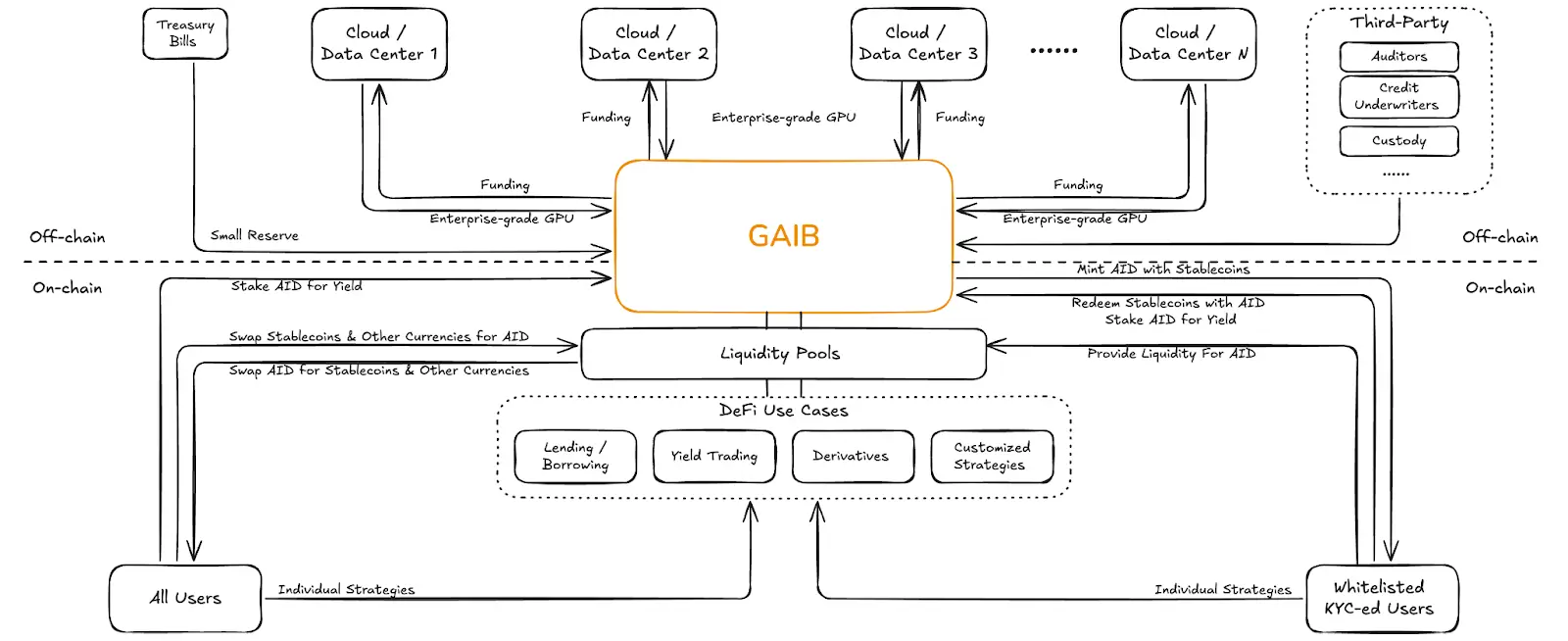
GAIB's Off-Chain Financing Model
GAIB collaborates with global cloud service providers and data centers, using GPU clusters as collateral to design three types of financing agreements:
Debt model: Fixed interest payments (annualized ~10–20%);
Equity model: Sharing GPU or robot income (annualized ~60–80%+);
Hybrid model: Interest + income sharing.
GAIB's risk management mechanism is built on the over-collateralization of physical GPUs and bankruptcy isolation legal structures, ensuring that in the event of default, cash flow can continue to be generated through the liquidation of GPUs or custody at partner data centers. Since enterprise-level GPUs have a short payback period, the overall term is significantly shorter than traditional debt products, with financing terms typically ranging from 3 to 36 months. GAIB collaborates with third-party credit underwriting institutions, auditors, and custodians to strictly implement due diligence and post-loan management, supplemented by treasury reserves as liquidity guarantees.
On-Chain Mechanism
Minting and Redemption: Through contracts, qualified users (Whitelist + KYC) can mint AID using stablecoins or redeem stablecoins with AID. Additionally, non-KYC users can also obtain it through secondary market trading.
Staking and Yield: Users can stake AID for sAID, which automatically accumulates yield, with value appreciating over time.
Liquidity Pool: GAIB will deploy AID liquidity pools on mainstream AMMs, allowing users to exchange stablecoins for AID.
DeFi Scenarios:
Lending: AID can be integrated into lending protocols to enhance capital efficiency;
Yield Trading: sAID can be split into PT/YT, supporting diverse risk-return strategies;
Derivatives: AID and sAID serve as underlying yield assets, supporting innovations in options, futures, and other derivatives;
Customized Strategies: Integrating Vaults and yield optimizers to achieve personalized asset allocation.
In summary, GAIB's core logic is to transform off-chain real cash flow into on-chain composable assets through the financing and tokenization of GPU + robot assets + treasury assets; then, through AID/sAID and DeFi protocols, form yield, liquidity, and derivatives markets. This design combines support from physical assets with on-chain financial innovation, building a scalable bridge between the AI economy and crypto finance.
V. Off-Chain: GPU Asset Tokenization Standards and Risk Management Mechanisms
GAIB transforms off-chain GPU financing agreements into on-chain tradable yield certificates through the SPC (Segregated Portfolio Company) structure. After investors deposit stablecoins, they will receive an equivalent amount of AI Synthetic Dollar (AID), which can be used to participate in the GAIB ecosystem. When investors stake and receive the staked asset sAID, they can share in the profits from GAIB's GPU and robot financing projects. As the underlying repayments flow into the protocol, the value of sAID continues to grow, allowing investors to ultimately redeem their principal and profits by burning tokens, thus achieving a one-to-one mapping of on-chain assets to real cash flow.
Tokenization Standards and Operational Process:
GAIB requires assets to have a complete collateral and guarantee mechanism, and financing agreements must include terms such as monthly monitoring, overdue thresholds, and compliance with over-collateralization, with underwriters required to have ≥2 years of lending experience and complete data disclosure. The process is as follows: investors deposit stablecoins → smart contracts mint AID (non-interest-bearing, T-Bills reserved) → holders stake and receive sAID (yield-bearing) → staked funds are used for GPU/robot financing agreements → SPC repayments flow into GAIB → the value of sAID increases over time → investors burn sAID to redeem principal and profits.
Risk Management Mechanism:
Over-collateralization — The financing pool assets typically maintain an over-collateralization rate of about 30%.
Cash reserves — About 5–7% of funds are allocated to an independent reserve account for interest payments and default buffers.
Credit insurance — Some of the default risk of GPU Providers is transferred through partnerships with compliant insurance institutions.
Default disposal — In the event of a default, GAIB and the underwriters can choose to liquidate GPUs, transfer them to other operators, or custody them to continue generating cash flow. The bankruptcy isolation structure of SPC ensures that each asset pool is independent and not affected by joint liabilities.
Additionally, the GAIB Credit Committee is responsible for establishing tokenization standards, credit assessment frameworks, and underwriting entry thresholds, and implements due diligence and post-loan monitoring based on a structured risk analysis framework (covering borrower fundamentals, external environment, transaction structure, and recovery rates) to ensure the safety, transparency, and sustainability of transactions.
Structured Risk Assessment Framework (For Reference Only)
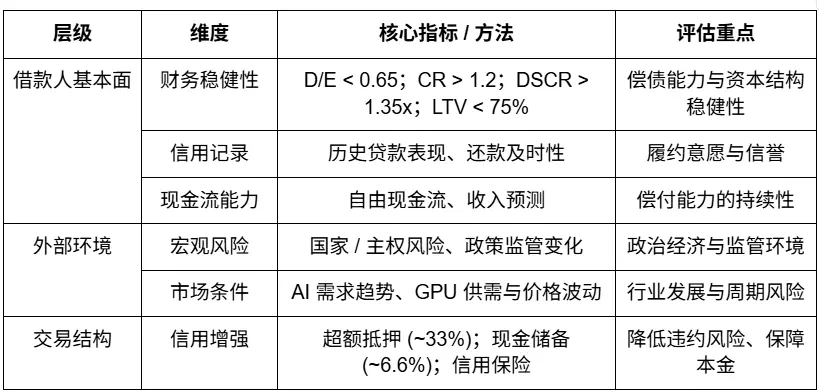
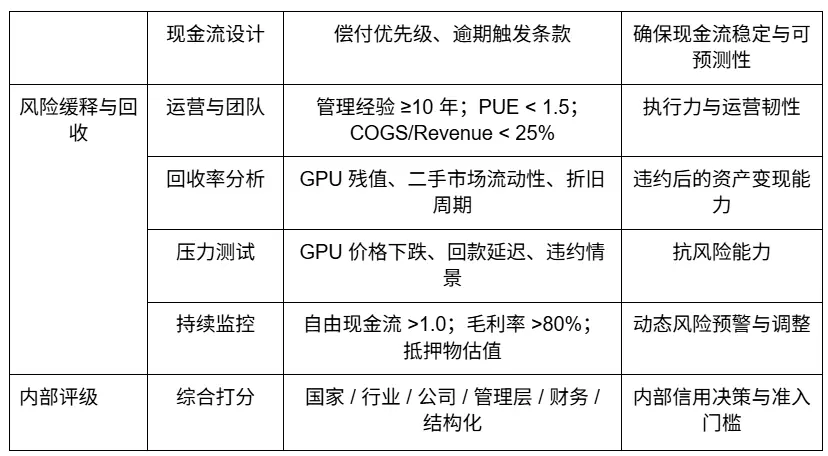
VI. On-Chain: AID Synthetic Dollar, sAID Yield Mechanism, and Alpha Deposit Program
GAIB Dual-Currency Model: AID Synthetic Dollar and sAID Liquidity Yield Certificate
The AID (AI Synthetic Dollar) launched by GAIB is a synthetic dollar supported by U.S. Treasury reserves. Its supply is dynamically linked to the protocol's capital: AID is minted when funds flow into the protocol and destroyed during profit distribution or redemption, ensuring that its scale remains consistent with the underlying asset value. AID itself only serves the functions of stable pricing and circulation, and does not directly generate profits.
To earn yields, users need to stake AID to convert it into sAID. sAID, as a tradable yield certificate, will gradually appreciate in value along with the real yields from the protocol layer (GPU/robot financing repayments, U.S. Treasury interest, etc.). The yield is reflected through the exchange rate of sAID/AID, and users do not need to take additional actions; simply holding sAID will automatically accumulate yields. Upon redemption, users can retrieve their initial principal and accumulated rewards after a cooling-off period.
Functionally, AID provides stability and composability, allowing it to be used for trading, lending, and liquidity provision; while sAID carries yield attributes, appreciating directly and further entering DeFi protocols to be split into principal and yield tokens (PT/YT), catering to different risk preferences of investors.
Overall, AID and sAID form the core dual-currency structure of the GAIB economic layer: AID ensures stable circulation, while sAID captures real yields. This design maintains the usability of synthetic stablecoins while providing users with an entry point for yields linked to the AI infrastructure economy.
Comparison of GAIB AID/sAID vs. Ethena USDe/sUSDe vs. Lido stETH Yield Models
The relationship between AID and sAID can be likened to Ethena's USDe/sUSDe and Lido's ETH/stETH: the former, as a synthetic dollar, does not generate yields by itself, and only accumulates yields automatically after being converted into sTokens. The difference lies in that the yield of sAID comes from GPU financing contracts and U.S. Treasuries, while sUSDe's yield comes from derivative hedging, and stETH relies on ETH staking.
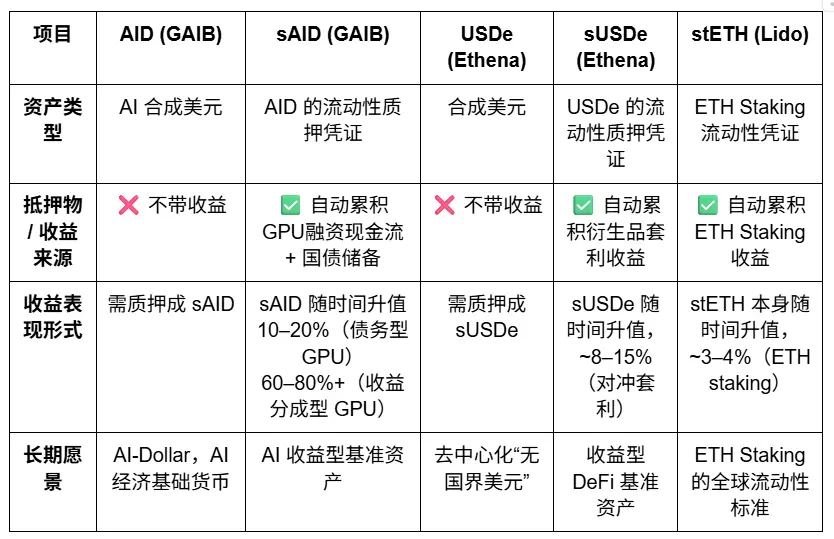
AID Alpha: Liquidity Launch and Points Incentive Mechanism Before GAIB Mainnet
AID Alpha officially launched on May 12, 2025, as the liquidity launch phase (Early Deposit Program) before the AID mainnet, aimed at guiding protocol funds through early deposits while providing participants with additional rewards and gamified incentives. All initial deposits will enter U.S. Treasuries (T-Bills) to ensure safety, and will gradually be allocated to GPU financing trades, forming a transition path from "low risk to high yield."
On the technical side, the AID Alpha smart contract follows the ERC-4626 standard, where users receive corresponding on-chain AIDα receipt tokens (e.g., AIDaUSDC, AIDaUSDT) for every dollar of stablecoin or synthetic stablecoin deposited, ensuring cross-chain consistency and composability.
In the Final Spice phase, GAIB opened diversified stablecoin entry points through the AIDα mechanism, including USDC, USDT, USR, CUSDO, and USD1. After users deposit stablecoins, they will receive corresponding AIDα receipt tokens (e.g., AIDaUSDC, AIDaUSD1), which represent deposit certificates and are automatically counted in the Spice points system, allowing further participation in DeFi combinations like Pendle and Curve.
As of now, the total deposit scale of AIDα has reached the $80M cap, with the details of the AIDα asset pool as follows:
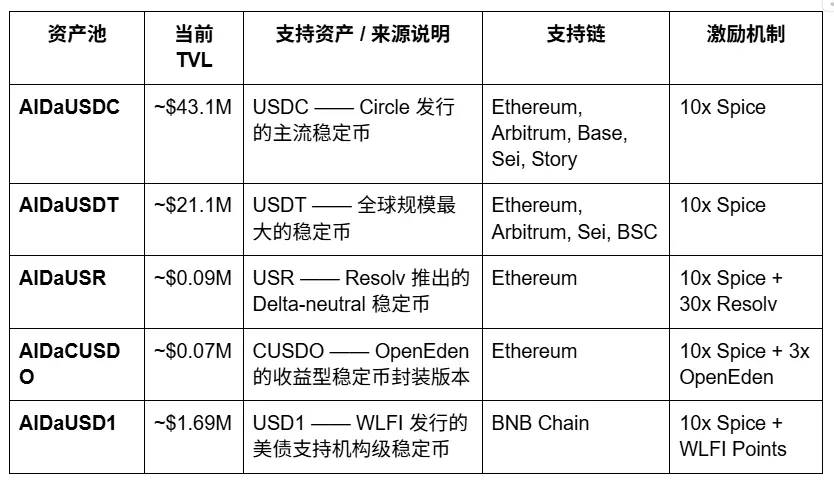
All AIDα deposits are subject to a lock-up period of no more than two months. After the activity ends, users can choose to exchange AIDα for mainnet AID and stake it as sAID to enjoy continuous yields, or directly redeem the original assets while retaining accumulated Spice points. Spice is the points system launched by GAIB during the AID Alpha phase, used to measure early participation and allocate future governance rights. The rule is "1 USD = 1 Spice/day," with additional multi-channel multipliers (e.g., 10x for deposits, 20x for Pendle YT, 30x for Resolv USR), up to a maximum of 30 times, forming a dual incentive of "yields + points." Additionally, the referral mechanism further amplifies yields (20% for first-level, 10% for second-level). After the Final Spice ends, points will be locked for governance and reward distribution upon the mainnet launch.
Furthermore, GAIB has issued 3,000 limited edition Fremen Essence NFTs as exclusive certificates for early supporters. The first 200 large depositors will retain their slots, while the remaining slots will be allocated through a whitelist and $1,500+ deposit qualifications. NFTs can be minted for free (only gas fees required), and holders will receive exclusive rewards upon the mainnet launch, priority testing rights for products, and core community identities. Currently, this NFT is priced at approximately 0.1 ETH in the secondary market, with a cumulative trading volume of 98 ETH.
VII. GAIB On-Chain Funds and Off-Chain Asset Transparency
GAIB maintains high standards for asset and protocol transparency, allowing users to track their on-chain asset categories (USDC, USDT, USR, CUSDO, USD1), cross-chain distribution (Ethereum, Sei, Arbitrum, Base, etc.), TVL trends, and details in real-time through the official website, DefiLlama, and Dune; at the same time, the official website also discloses the allocation ratios of off-chain underlying assets, amounts of active deals, expected yields, and the status of selected pipeline projects.
GAIB Official Website: https://aid.gaib.ai/transparency
Defillama: https://defillama.com/protocol/tvl/gaib
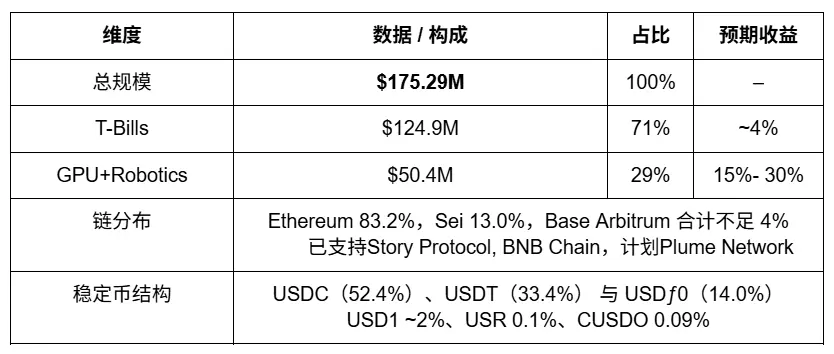
As of October 2025, GAIB manages a total asset scale of approximately $175.29M, with a "dual-layer allocation" that balances robustness while providing excess returns from AI Infra financing.
Reserve assets (Reserves) account for 71%, approximately $124.9M, primarily in U.S. Treasuries, with an expected annualized yield of about 4%;
Deployed assets (Deployed) account for 29%, approximately $50.4M, used for off-chain GPU and robot financing projects, with an average annualized yield of about 15%.
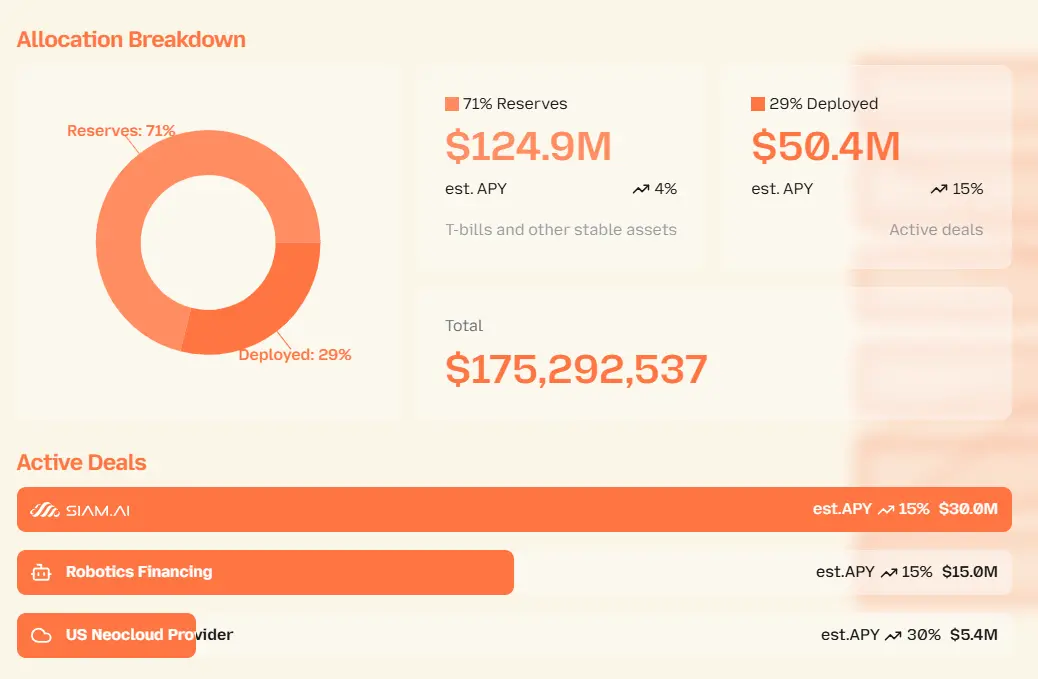
In terms of on-chain fund distribution, according to the latest data from Dune, Ethereum accounts for 83.2%, Sei for 13.0%, and Base and Arbitrum together account for less than 4%. By asset structure, the funds mainly come from USDC (52.4%) and USDT (47.4%), with the remainder being USD1 (~2%), USR (0.1%), and CUSDO (0.09%).
In terms of off-chain asset distribution, GAIB's investment projects and fund deployment are consistent, including Siam.AI in Thailand ($30M, 15% APY), two Robotics Financing projects (totaling $15M, 15% APY), and the US Neocloud Provider ($5.4M, 30% APY). Meanwhile, GAIB has established a project reserve of approximately $725M, with a broader total project reserve outlook of $2.5B+ over 1–2 years, covering GMI Cloud and multiple regional Nvidia Cloud Partners (Asia $200M and $300M, Europe $60M, UAE $80M), North American Neocloud Providers ($15M and $30M), and robot asset providers ($20M), laying a solid foundation for future expansion and scaling.
VIII. Ecosystem: Computing Power, Robotics, and DeFi
GAIB's ecosystem consists of three main components: GPU computing resources, robotic innovation enterprises, and integrated DeFi protocols, aiming to form a complete closed loop of "real computing power assets → financialization → DeFi optimization."
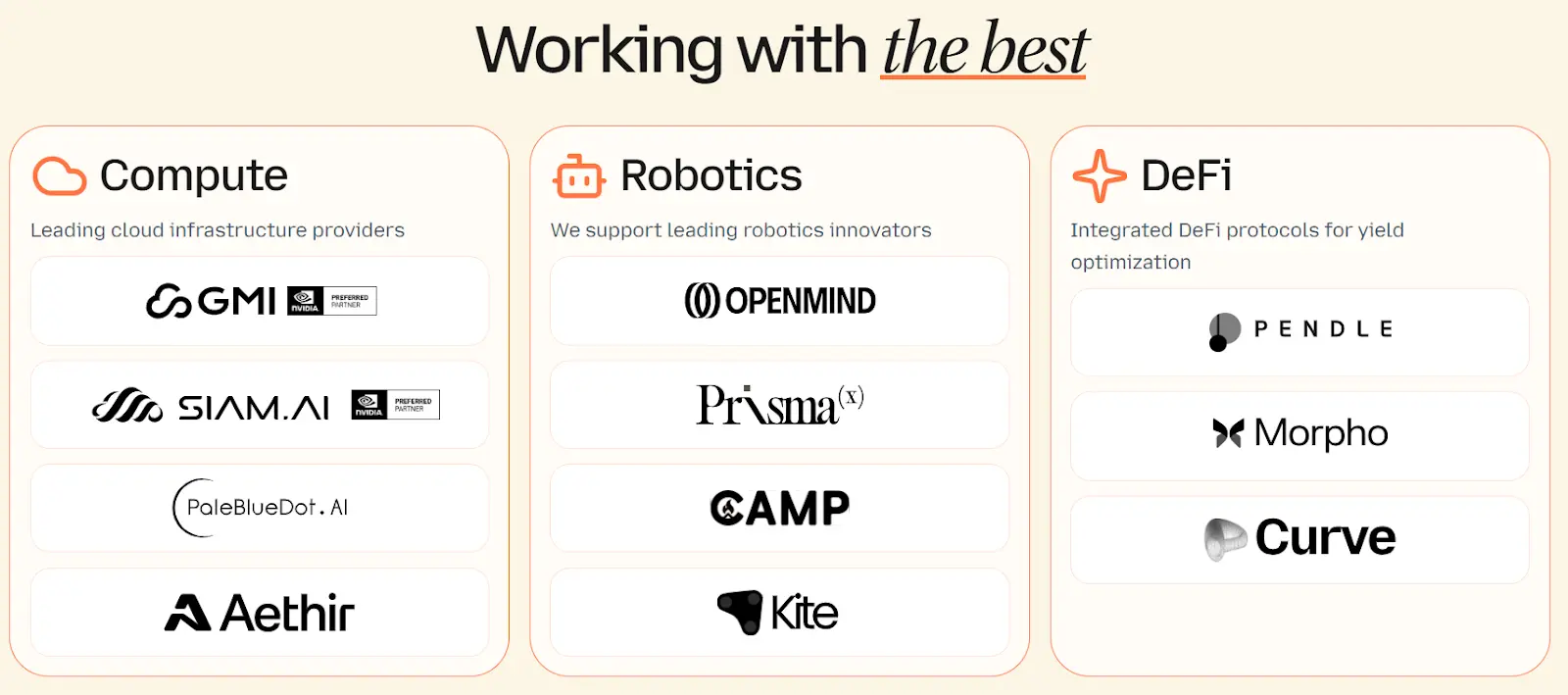
GPU Computing Ecosystem Resources: On-Chain Computing Power Assets
In the on-chain financing ecosystem of AI infrastructure, GAIB has partnered with various computing service providers, covering sovereign/enterprise-level clouds (GMI, Siam.AI) and decentralized networks (Aethir, PaleBlueDot.AI), ensuring both computing power stability and expanding the narrative space of RWA.
GMI Cloud: One of NVIDIA's six global Reference Platform Partners, operating seven data centers across five countries, has raised approximately $95M. Known for low latency and AI-native environments. Through GAIB's financing model, its GPU expansion has stronger cross-regional resilience.
Siam.AI: Thailand's first sovereign-level NVIDIA Cloud Partner, achieving up to 35x performance improvement and 80% cost reduction in AI/ML and rendering scenarios. Completed $30M GPU Tokenization with GAIB, establishing its first GPU RWA case and securing a first-mover advantage in the Southeast Asian market.
Aethir: A leading decentralized GPUaaS network with over 40,000 GPUs (including over 3,000 H100). In early 2025, completed the first GPU Tokenization pilot with GAIB on the BNB Chain, raising $100K in just 10 minutes. Future plans include exploring the integration of AID/sAID with Aethir staking to create dual yields.
PaleBlueDot.AI: An emerging decentralized GPU cloud, its participation strengthens GAIB's DePIN narrative.
Robotics Ecosystem: On-Chain Financing for Embodied Intelligence
GAIB has officially entered the embodied AI sector, extending the GPU Tokenization model to the robotics industry, building a "Compute + Robotics" dual-engine ecosystem centered on SPV collateral structures and cash flow distribution, and packaging robot and GPU yields through AID/sAID to achieve on-chain financialization of hardware and operations. Currently, a total of $15 million has been deployed in robot financing, with an expected annualized yield of about 15%. Partners include OpenMind, PrismaX, CAMP, Kite, and SiamAI Robotics, covering multi-dimensional innovations in hardware, data flow, and supply chain.
PrismaX: Positioned as "robots as mining machines," PrismaX connects operators, robots, and data demanders through a remote operation platform, generating high-value motion and visual data at a price of about $30–50 per hour, and has validated early commercialization through a $99/session payment model. GAIB provides financing to expand the scale of robots, with data sale revenues flowing back to investors through AID/sAID, forming a financialization path centered on data collection.
OpenMind: OpenMind provides identity authentication, trusted data sharing, and multi-modal integration through the FABRIC network and OM1 operating system, akin to the industry's "TCP/IP." GAIB tokenizes these tasks and data contracts on-chain, providing capital support. The collaboration enables a complementary relationship of "technological credibility + financial assetization," allowing robotic assets to transition from the laboratory stage to scalable, financeable, and verifiable development.
Overall, GAIB is gradually building a complete ecosystem covering the robotic hardware, operations, and data value chain through collaboration with PrismaX's data network, OpenMind's control systems, and CAMP's infrastructure deployment, accelerating the industrialization and financialization of embodied intelligence.
DeFi Ecosystem: Protocol Integration and Yield Optimization
During the AID Alpha phase, GAIB deeply integrated AID/aAID assets with various DeFi protocols, forming a cross-chain, diversified yield optimization system through yield splitting, liquidity mining, collateral lending, and yield enhancement, with Spice points serving as a unified incentive.
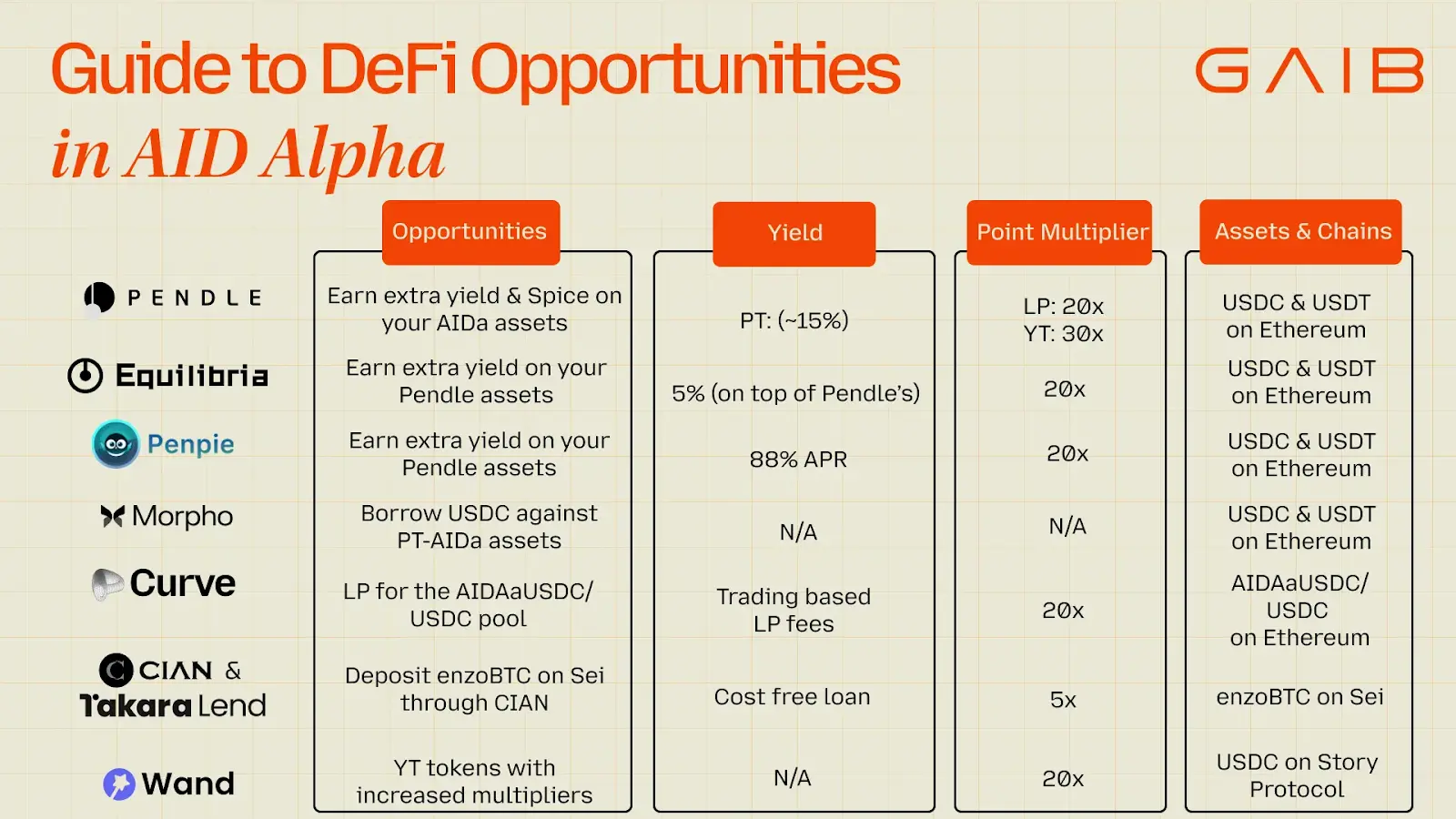
Pendle: Users can split AIDaUSDC/USDT into PT (Principal Token) and YT (Yield Token). PT offers about 15% fixed yield, while YT carries future yields and enjoys a 30x points bonus, with LP liquidity providers receiving 20x points.
Equilibria and Penpie: As yield enhancers for Pendle, the former can add an extra ~5% on top of existing yields, while the latter can reach up to 88% APR, both with a 20x points multiplier.
Morpho: Supports using PT-AIDa as collateral to borrow USDC, allowing users to obtain liquidity while maintaining their positions, and expanding into the mainstream lending market on Ethereum.
Curve: The AIDaUSDC/USDC liquidity pool can earn trading fee revenues while also receiving 20x points, suitable for participants preferring conservative strategies.
CIAN & Takara (Sei Chain): Users can collateralize enzoBTC on Takara to borrow stablecoins, which are then automatically injected into GAIB strategies through the CIAN smart treasury, combining BTCfi and AI Yield, with a 5x points bonus.
Wand (Story Protocol): On the Story chain, Wand provides a PT/YT split structure similar to Pendle for AIDa assets, with YT Tokens earning 20x points, further enhancing the cross-chain combinability of AI Yield.
Overall, GAIB's DeFi integration strategy covers Ethereum, Arbitrum, Base, Sei, and Story Protocol, BNB Chain, and Plume Network, achieving comprehensive coverage from fixed yields, leveraged yields to cross-chain liquidity through Pendle and its ecosystem enhancers (Equilibria, Penpie), lending markets (Morpho), stablecoin DEX (Curve), BTCfi treasury (CIAN + Takara), and the native AI narrative of the Wand protocol.
IX. Team Background and Project Financing
The GAIB team brings together experts from the fields of AI, cloud computing, and DeFi, with core members having previously worked at institutions such as L2IV, Huobi, Goldman Sachs, Ava Labs, and Binance Labs. Team members graduated from Cornell University, the University of Pennsylvania, Nanyang Technological University, and the University of California, Los Angeles, possessing deep experience in finance, engineering, and blockchain infrastructure, collectively building a solid foundation connecting real-world AI assets with on-chain financial innovation.
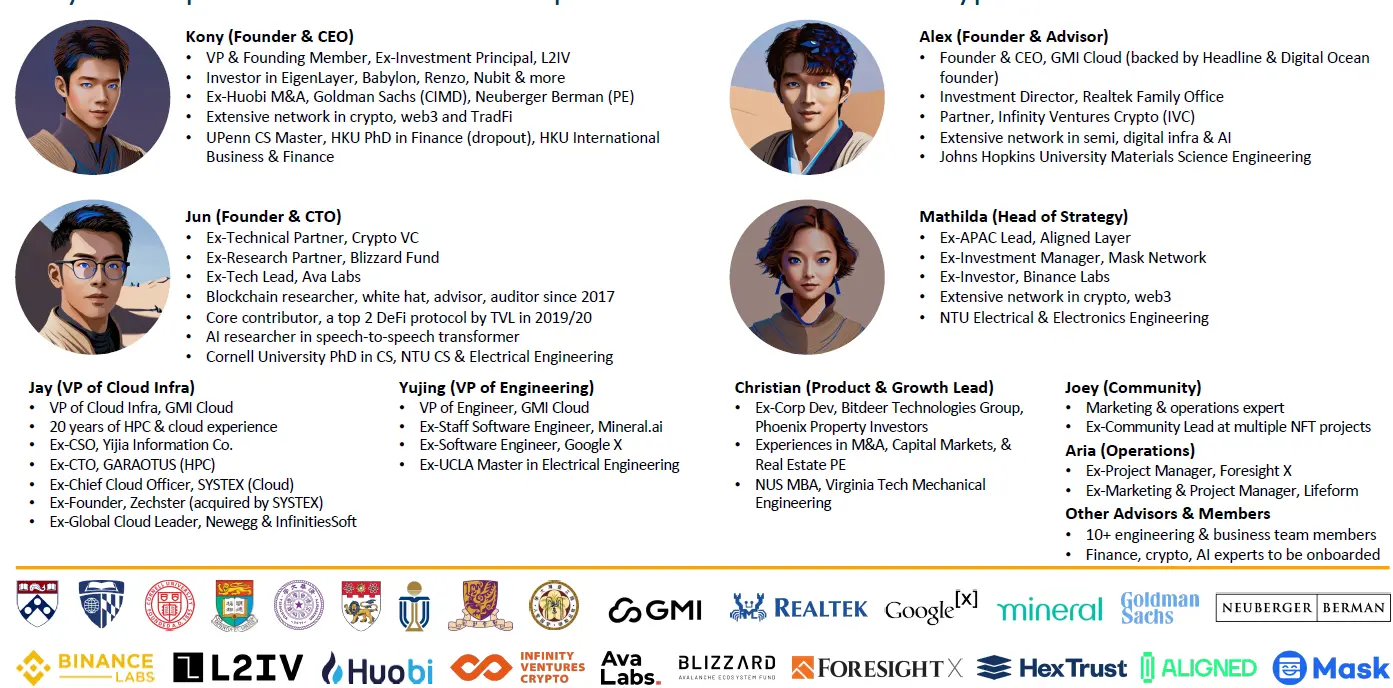
Kony Kwong is the co-founder and CEO of GAIB, with cross-border experience in traditional finance and crypto venture capital. He was previously an investor at L2 Iterative Ventures and responsible for fund management and mergers and acquisitions at Huobi M&A, having worked early in his career at CMB International, Goldman Sachs, and CITIC Securities. He graduated with first-class honors in International Business and Finance from the University of Hong Kong and holds a master's degree in Computer Science from the University of Pennsylvania. He believes that AI infrastructure lacks a financialization ("-fi") component, which is why he founded GAIB to transform real computing power assets like GPUs and robots into on-chain investable products.
Jun Liu is the co-founder and CTO of GAIB, with a background in both academic research and industry practice, focusing on blockchain security, cryptoeconomics, and DeFi infrastructure. He was previously the Vice President at Sora Ventures and served as a technical manager at Ava Labs, supporting the BD team and responsible for smart contract audits, while leading technical due diligence at Blizzard Fund. He holds a dual degree in Computer Science and Electrical Engineering from National Taiwan University and is pursuing a Ph.D. in Computer Science at Cornell University, participating in IC3 blockchain research. His expertise lies in building secure and scalable decentralized financial architectures.
Alex Yeh is the co-founder and advisor of GAIB, and also serves as the founder and CEO of GMI Cloud. GMI Cloud is one of the world's leading AI-native cloud computing service providers and has been selected as one of six NVIDIA Reference Platform Partners. Alex has a background in semiconductors and AI Cloud, managing the Realtek family office, and has previously worked at CDIB and IVC. At GAIB, he is primarily responsible for industry collaboration, integrating GMI's GPU infrastructure and client network into the protocol, and promoting the financialization of AI Infra assets.
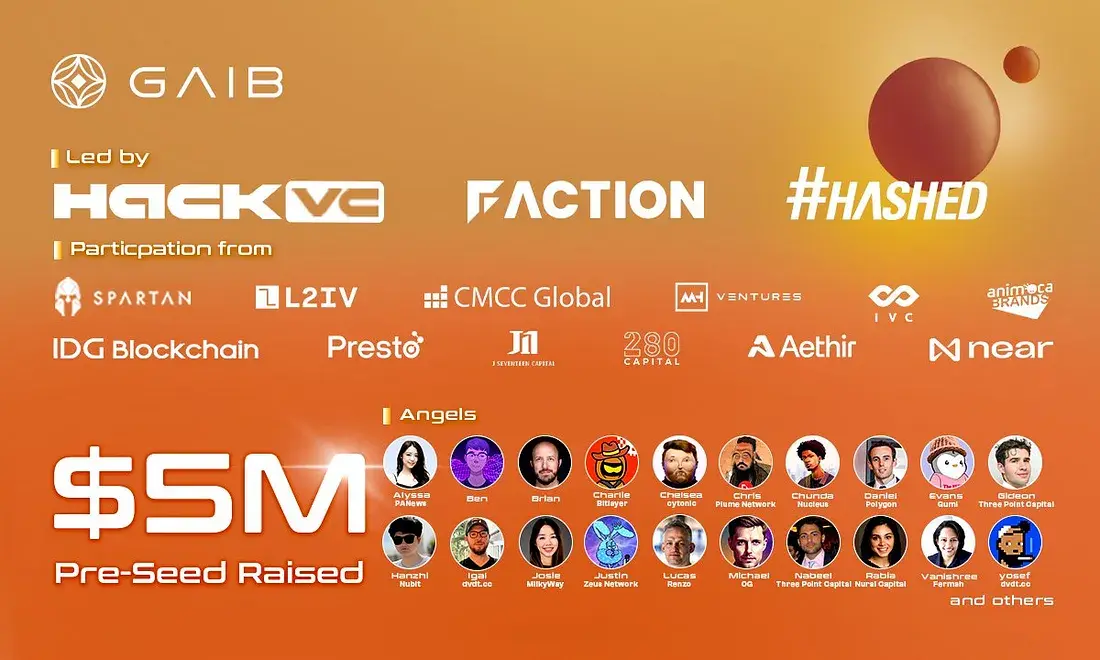
In December 2024, GAIB completed a $5 million Pre-Seed financing round, led by Hack VC, Faction, and Hashed, with participation from well-known institutions including The Spartan Group, L2IV, CMCC Global, Animoca Brands, IVC, MH Ventures, Presto Labs, J17, IDG Blockchain, 280 Capital, Aethir, NEAR Foundation, and several angel investors from the industry and crypto fields. Subsequently, in July 2025, GAIB secured a $10 million strategic investment led by Amber Group, with multiple Asian investors participating. This funding will focus on the tokenization of GPU assets, further enhancing GAIB's infrastructure, expanding GPU financialization products, and deepening strategic cooperation with AI and crypto ecosystems to strengthen institutional participation in on-chain AI infrastructure.
X. Summary: Business Logic and Potential Risks
Business Logic: GAIB's core positioning is RWAiFi, which aims to transform AI infrastructure assets (GPUs, robots, etc.) into composable financial products through on-chain methods, forming a closed loop of "real assets → cash flow securitization → DeFi optimization." Its business logic is based on three points:
Asset Side: GPUs and robots possess the characteristics of "high-value hardware + predictable cash flow," meeting the basic requirements for RWA. GPUs, due to their standardization, clear residual value, and strong demand, have become the most realistic entry point; robots represent a longer-term exploration direction, gradually achieving cash flow on-chain through remote operation, data collection, and RaaS models.
Funding Side: Through a dual-layer structure of AID (stable settlement, non-interest-bearing, T-Bills reserves) and sAID (yield-bearing fund tokens, underpinned by financing portfolios + T-Bills), GAIB achieves stable circulation and separation of yield capture. It releases yield and liquidity through DeFi integrations such as PT/YT, lending, and LP liquidity.
Ecosystem Side: Collaborating with sovereign-level GPU clouds like GMI and Siam.AI, decentralized networks like Aethir, and robotics companies like PrismaX and OpenMind, GAIB establishes an industrial network across hardware, data, and services, promoting the dual-engine development of "Compute + Robotics."
Additionally, GAIB adopts an SPC (Segregated Portfolio Company) structure to transform off-chain financing agreements into on-chain yield certificates. The core mechanisms include:
Financing Model: Debt (10–20% APY), revenue sharing (60–80%+), hybrid structures, short terms (3–36 months), and quick payback periods.
Credit and Risk Control: Ensuring safety through over-collateralization (about 30%), cash reserves (5–7%), credit insurance, and default handling (GPU liquidation/custodial operations); combined with third-party underwriting and due diligence, an internal credit rating system is established.
On-Chain Mechanism: AID minting/redeeming and sAID yield accumulation, combined with protocols like Pendle, Morpho, Curve, CIAN, and Wand, to achieve cross-chain, multi-dimensional yield optimization.
Transparency: The official website, DefiLlama, and Dune provide real-time tracking of assets and fund flows, ensuring a clear correspondence between off-chain financing and on-chain assets.
Potential Risks: GAIB and its related products (AID, sAID, AID Alpha, GPU Tokenization, etc.) enhance yield visibility through on-chain transparency, but underlying risks still exist, and investors need to carefully assess their risk tolerance before participating:
Market and Liquidity Risks: GPU financing yields and digital asset prices are affected by market fluctuations, and returns are not guaranteed; products have lock-up periods, and if market conditions worsen, investors may face liquidity shortages or discounted exit risks.
Credit and Execution Risks: GPU and robot financing often involve small and medium-sized enterprises, which have a relatively higher probability of default; asset recovery heavily relies on off-chain execution, and if disposal is not smooth, it will directly impact investor returns.
Technical and Security Risks: Smart contract vulnerabilities, hacking attacks, oracle manipulation, or loss of private keys can lead to asset losses; deep integration with third-party DeFi protocols (such as Pendle, Curve, etc.) can enhance TVL growth but also introduces external protocol security and liquidity risks.
Asset Characteristics and Operational Risks: GPUs have standardized and residual value markets, while robot assets are highly non-standardized, with operations dependent on utilization and maintenance; during cross-regional expansion, robot assets are particularly susceptible to regulatory differences and policy uncertainties.
Compliance and Regulatory Risks: The computing power assets invested by GAIB belong to a new market and asset class, which may not fall under the coverage of traditional financial licenses. This could lead to regional regulatory issues, including restrictions on business operations, asset issuance, and usage.
Disclaimer: This article was created with the assistance of the AI tool ChatGPT-5. The author has made efforts to proofread and ensure the information is true and accurate, but some omissions may still exist. It should be particularly noted that the crypto asset market generally experiences a divergence between project fundamentals and secondary market price performance. The content of this article is for information integration and academic/research exchange only, does not constitute any investment advice, and should not be regarded as a recommendation for buying or selling any tokens.
免责声明:本文章仅代表作者个人观点,不代表本平台的立场和观点。本文章仅供信息分享,不构成对任何人的任何投资建议。用户与作者之间的任何争议,与本平台无关。如网页中刊载的文章或图片涉及侵权,请提供相关的权利证明和身份证明发送邮件到support@aicoin.com,本平台相关工作人员将会进行核查。




